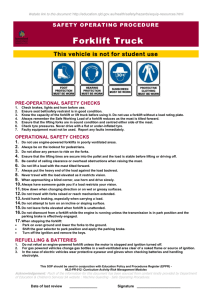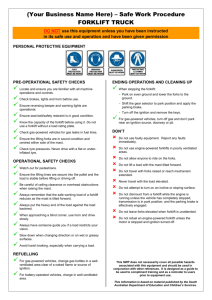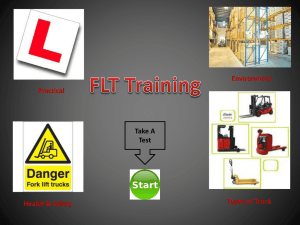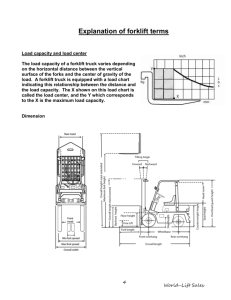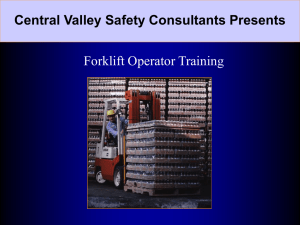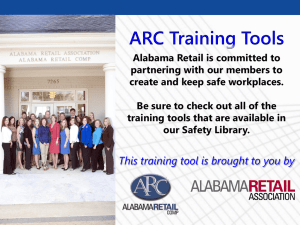D-RCS FORKLIFT TRAINING PROGRAM
advertisement
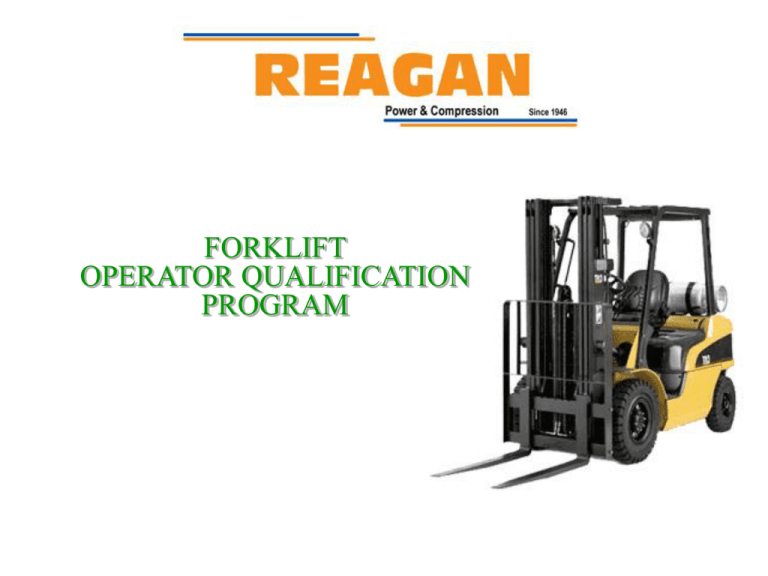
FORKLIFT OPERATOR QUALIFICATION PROGRAM Objectives of this course • To become qualified to operate a forklift (aka forktruck or Powered Industrial Truck) • • • • Learn the rules for safe operation How to avoid forktruck accidents How to prevent high maintenance cost Verify your understand of what you learned with a quiz S T t tru ruc ipo ck k b ver by y t ru E c le fall va in k g te lo d em ad Im R ploy pr op an e er of e fd m oc ai nt en k Tr uc Lo an c k s st t c e ru on c tro k O m l ve a r co U te nl ria m oa e l di b ng Fa y C un u O c h lt y oc tru ck ke d Fe tra il ll of er Im f tr uc pr k o E le per ct ro us cu e at io ns S Causes of Accidents 30 25 20 15 10 5 0 A cc S id en ta la ct fro m fa lli ng iva t io n 2 of c on tro ls fo rk s at er ia l on m ov er tru ck ob je ct tru ck or ra n pl at fo rm by by be tw ee n an d t ip pi ng tru ck by tru ck tru ck S C ru sh ed be tw ee n Fa ll C ru sh ed C ru sh ed Causes of Fatalities 45 40 35 30 25 20 15 10 5 0 Qualification Program • This program is not designed to "teach" employees how to operate a forklift. • It is intended only to confirm the safety aspects of forklift operation for those people already familiar with its operation. Who Can Use A Lift Truck? “Only trained and authorized personnel shall be permitted to operate forklifts.” Training requirement • Phase 1: Classroom instruction & quiz • Phase 2: Observation of the trainee operating a truck by a person experienced in forklift operation Notes about Phase 2: – training must not endanger the trainee or other employees. – the observation must be completed on each truck the employee will be assigned to operate. Refresher training is required when . . . • The operator has been observed operating in an unsafe manner • The operator is involved in an incident or nearmiss • The operator is assigned to operate a different type truck • A condition in the workplace changes in a manner that could affect safe operation of the truck. • At least every 3 years. HIGH ACCIDENT & MAINTENACE COSTS Are usually results of : • Safety rule violations • Near misses • Hot-Dogging • Lack of inspections General Requirements • Modifications or additions to forklifts must be approved, in writing, by the manufacturer • Name plates must reflect all front-end attachments • Nameplates must be in place and legible General Requirements (cont.) • Truck shall not be used around flammable vapors or hazardous concentrations of metal dust unless they are designated as a DY, EE, or EX • Attention should be paid to carbon monoxide (CO) levels in work areas where truck are operating Load Center Load center MAXIMUM LOAD • There will be several weights stenciled on the nameplate. • The weights listed will be with the uprights vertical and the center of gravity of the load at various distances from the backrest. 4350# with load center 24” from backrest 24 4350 Name Plate Tire size 2490 cap when load center is 20” from backrest Capacity 2190 cap when load center is 30” from backrest Load Center Tire press Important! The higher the lift, the lower the capacity Movement of the stability triangle 2. Truck is loaded or stopped quickly 1. Truck stopped, no load Stability Triangle 3. Truck is loaded on right side or turning left 5. Truck is loaded and 4. Truck is lifting a load with the loaded on left mast titled back side and/or turning right Key points about the stability triangle • If you get outside the stability triangle, the truck could turn over • No quick stops or turns • Keep load low • Inch slowly when load is lifted for deposit • Keep loads stable on forks so they don’t shift • Creep when carrying containers of liquid • Tilt back no more than necessary SURVIVING A TIP-OVER • • • • Don’t jump Hold on to steering wheel tightly Brace feet with wide stance Lean away from the tip direction REAR-END STEERING • Due to rear-end steering, operators must slow down in order to watch the tail swing and the tips of the forks at the same time. • You can’t do this if your driving too fast. What’s wrong in this picture? Load is way to high Load height is O.K. if stopped to stack, right? Stopped too fast! Maybe should be driving backwards Driver not at the controls FORKS (CONT.) • When a forklift is not in use, the forks must be grounded and leveled. yes no FORKS (CONT.) • Under no circumstances should anyone be allowed under raised forks, whether loaded or empty. • This includes fingers & toes. ELEVATION OF FORKS • When traveling on level surfaces the forks should never be raised more than about 4” from the floor or ground. • When on unlevel surfaces, the forks should not be raised any higher than necessary to clear the ground. TRUCK INSPECTIONS • Forklifts shall be examined before being placed in service • Trucks must be inspected at the end of each shift when used around-the-clock • Trucks used intermittently must be inspected at the beginning of each day that the truck is used • Daily inspections shall be retained for 45 days • Monthly inspections shall be retained for at least 13 months. INSPECTIONS (cont.) The inspection must at least include the following : A. Leaks (water, fuel, hydraulic fluid, etc.) B. Tire damage and adequate inflation C. Faulty operation of controls INSPECTIONS (cont.) D. Brake condition (service and emergency brakes) E. Proper steering F. Proper accessory operation (horn, lights, ignition switch, etc.) G. Proper operation of lift/tilt mechanisms INSPECTIONS (cont.) H. Defects in forks I. Battery charging J. Fuel connections/gauges K. Battery plug connection (if it’s electric) Checking the oil Operating range Add or Low Be on a level surface to check the oil. Like on a concrete pad or shop floor. full From low to full could be 1 Qt. to 1 gallon. Put a little in and check level. Keep doing that. DO NOT OVERFILL • Any maintenance problems should be brought to the attention of supervision so that appropriate repairs can be made. INSPECTIONS (cont.) • Forklifts in an unsafe condition should never be used. NATIONAL SAFETY COUNCIL SAYS . . . • The most serious defect is BRAKE FAILURE. DAMAGE TO FORKLIFT • If the forklift is damaged in any way or develops any kind of mechanical problem while being used it must be immediately reported to your supervisor. • Do not park a defective forklift without tagging it out & telling your supervisor. OSHA SAYS . . . • Only trained and/or qualified persons should make repairs to forklifts. Operating Rules FOLLOWING ANOTHER TRUCK • When one forklift is following another, the following forklift should maintain a distance of three (3) trucks behind the first. QUICK STOPS • Although the forklifts can be stopped in a short distance, the load cannot stop as fast. • A quick stop may cause the forklift to loose the load or tip forward. USE OF HORN • The horn should be used to warn pedestrians that you are approaching • The horn should also be sounded upon entering a building or rounding a blind corner • Sound the horn and look in direction of travel BEFORE backing USE OF HORN (cont.) • It is especially important to sound the horn when entering or leaving buildings where employees may be walking across the path of the forklift. • Also, be especially careful when entering a building from outside as your eyes will not be adjusted to the lower light. • Horns should never be used to startle fellow employees. UNATTENDED FORKLIFTS • The definition of an unattended forklift is: – when you are not within clear view of the truck, or – when you are more than twenty five feet (25) feet away from it. UNATTENDED FORKLIFT (cont.) So. . .If the forklift is unattended, you must • shut down the engine • fully ground the forks • neutralized the controls • set the emergency brake, and • not parked on an incline (unless chocks are used) UNATTENDED FORKLIFT (cont.) • If you get off of the forklift but do not leave it unattended then you must – Lower the forks to the ground, – Neutralize the controls and – Set the emergency brake – Chock wheels if on an incline UNDER NO CIRCUMSTANCES. . . • Should a forklift be allowed to lift any more than its rated capacity. STABILITY OF LOAD & TRAVELING • Loads should be stable. Remember that shop floors have rough places and so does the yard. • Loads should be balanced, secure and stable so there is no possibility of loosing the load during transit. TRAVELING • Keep the load against the backrest (mast) as much as possible. TRAVELING (cont.) • 10% grade is when a slope changes 10 feet in height in a 100 feet of distance. • When going up or down an incline of 10 percent grade or more while loaded, keep the load uphill. • In other words, go up the grade in forward and come down the grade in reverse. RAILROAD TRACKS • When crossing railroad tracks, the truck should cross the tracks diagonally (at an angle). • No parking within 8 ft. of the center of the RR tracks TRAVELING (cont.) • Whether loaded or unloaded, do not run over any avoidable objects such as beam, pipe, loose items, etc. as tire damage and possible tipping may occur. • Also, avoid any wet spots on shop floors as this will effect braking ability and steering control. MANEUVERING • When unable to see in front of you because of a large load, you should drive backwards or have a spotter. PERSONNEL LIFTING • Employees should never be allowed to be lifted on the forks unless the proper personnel basket is used. • Safety platform must be firmly secured to the lifting carriage and/or forks. • Means shall be provided whereby personnel on the platform can shut off power to the truck. RIDERS • Under no circumstances should anyone be on a forklift except the operator (unless a safe place is provided) • This is the operator’s responsibility OVERHEAD CLEARANCE • Always watch for overhead clearance such as piping, overhead doors, craneways, etc. • Never get any closer to an electrical line than 20 feet. TRAVELING • Travel should be smooth, slow, cautious and the operator must always look in the direction of travel before beginning to move. TRAVELING (cont.) • The mast should be tilted slightly back, when possible, while traveling with a load. TRAVELING (cont.) • Forklifts must never be driven up to someone standing in front of a bench or other fixed object. OPERATING • Arms and legs should never be outside the confines of the forklift cab or operators position. OPERATING (cont.) • Never pass another forklift going in the same direction while in the shops. • Pedestrians always have the right of way. MANEUVERING & STACKING • Do not combine turning, raising/lowering forks and depositing load all at one time. • The procedure should be as follows: MANEUVERING & STACKING (cont.) 1. Drive up to the place you intend to deposit or pick up load and stop. 2. Raise or lower forks and tilt forward or back to deposit or pick up load. MANEUVERING & STACKING (cont.) 3. Creep forward and deposit or pick up load. 4. Adjust forks and tilt. 5. Look to direction of travel. 6. Slowly begin travel. DAMAGE REPORTING • While handling material, report any damage to the material immediately to your supervisor. • The damaged material may take time to replace and the quicker the damage is reported, the quicker it can be fixed or re-ordered. DAMAGE REPORTING (cont.) • Report any damage to property immediately. This includes damage – – – – – To doors, Buildings, Structures, The forktruck, or Other equipment, etc. HANDLING VESSELS • Name plates on bottles & scrubbers - do not allow them to be damaged. • Screwed fittings - do not allow the bottle to rest on these fittings or let the bottle roll over on these fittings • Use caution so that flange faces are not damaged • To accomplish this, the bottles may have to be suspended under the forks using chokers rather than sitting on the forks. HANDLING VESSELS (cont.) • It is the operator’s responsibility to figure out how to avoid damage to these vessels or any other load. REFUELING • During refueling the engine must be shut down. • Forklift must be parked away from any hot work or heat producing operations. • No smoking. • If propane fuel is used, return empty tank to the proper place. Propane Line up holes with peg Relief valve must be pointed UP WHEN PARKING • When parking the forklift be sure it is not blocking – – – – Aisles, Fire extinguishers, Electrical panels , or Exit doors. WHEN PARKING (cont.) • Shut the engine down, • Set the handbrake, • Ground and level forks, • Neutralize controls, and • Chock wheels if on an incline. MOUNTING AND DISMOUNTING • Do not “jump” off the forklift • Use handrails and take your time (maintain 3-point contact at all times) • If the anti-skid surfaces get worn down anti-skid tape can be put on them. FINALLY . . . • • • • • Take care of the machine Don't overload Report damage Operate at a safe speed Obey all the rules QUIZ
